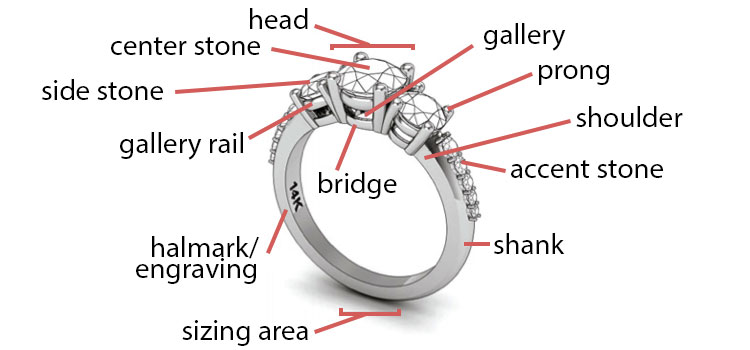…like a rolling stone! (four-week project)
Assignment brief:
Using Rhino (not Rhino Gold) and our in house ASIGA 3D printers to model a wearable piece that will accept a stone or multiple stones. Try to push the advantages that come from using 3D printing versus traditional hand skills.
Learning outcomes:
Students will learn advanced modeling techniques in Rhino for the Form1, ASIGA and Shapeways in order to design, 3D print, cast and finish a wearable piece that will accept precious/semi precious stones.
Skills list:
Rhino: Modeling for stone-setting. Flow along surface,
Shapeways:
Material options, Wax printing versus precious metal printing
Casting:
In house versus out of house, casting versus fabricating. Advantages versus disadvantages
Basic stone knowledge, Stone setting at the bench, laser welding
Measuring stones, modeling settings, calculating for shrinkage, modeling in sprues.
Concept:
Creating a wearable piece that takes advantage of 3D printing to better understand setting stones using a digital output workflow
Research:
John Cogswell: Creative Stone Setting Find settings for inspiration, Field trip to Stachura, In house collection of stones
Questions:
How can you use 3D printing in a way that pushes stone setting? Or wearability?
Can it be made by hand?
What is the advantage of making it with a 3D printer?
Which stones will deliver your conceptual content more effectively
Is there a more effective/creative way to set stones using 3D printing?
Can it be made by hand?
What is the advantage of making it with a 3D printer?
Which stones will deliver your conceptual content more effectively
Is there a more effective/creative way to set stones using 3D printing?
Expectations:
A wearable piece that takes advantage of in house 3D printing technology to include stones that are relevant to conceptual content. Tests
and mock-ups are required. Multiple prints and castings may need to be made. With this and all projects for this course renders and spec drawings will be turned in.

















RULE OF THIRDS
The Mohs scale of mineral hardness was created by German mineralogist, Friedrich Mohs, in 1822 to measure the relative hardness or scratch resistance of various minerals. He based it on ten readily available minerals. As it is an ordinal scale, two minerals must be compared to decide which is harder. The scale is neither linear nor logarithmic. For example, corundum is twice as hard as topaz, but diamond is almost four times as hard as corundum.
The hardness of a material is measured against the scale by finding the hardest material that that the given material can scratch, or the softest material that can scratch the given material.
Mohs' original scale is as follows:
| Hardness | Material | Absolute Hardness |
| 1 | Talc (Mg3Si4O10(OH)2) | 1 |
| 2 | Gypsum (CaSO4·2H2O) | 3 |
| 3 | Calcite (CaCO3) | 9 |
| 4 | Fluorite (CaF2) | 21 |
| 5 | Apatite (Ca5(PO4)3(OH-,Cl-,F-)) | 48 |
| 6 | Orthoclase (KAlSi3O8) | 72 |
| 7 | Quartz (SiO2) | 100 |
| 8 | Topaz (Al2SiO4(OH-,F-)2) | 200 |
| 9 | Corundum (Al2O3) | 400 |
| 10 | Diamond (C) | 1500 |
To give some examples from everyday life,
a fingernail has a hardness of 2;
a copper penny, about 3;
a knife blade, 5;
window glass, 5.5;
and a steel file, 6.5.
a fingernail has a hardness of 2;
a copper penny, about 3;
a knife blade, 5;
window glass, 5.5;
and a steel file, 6.5.
Here are the Mohs scale ratings for 144 types of gemstones:



















































































No comments:
Post a Comment